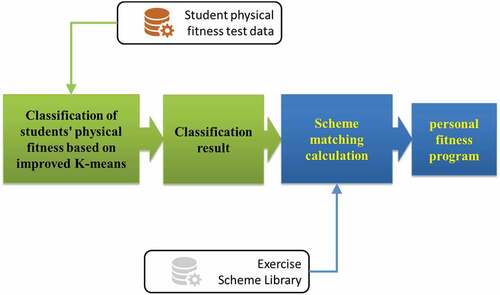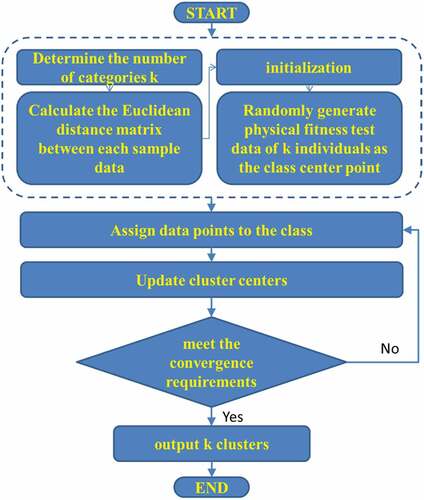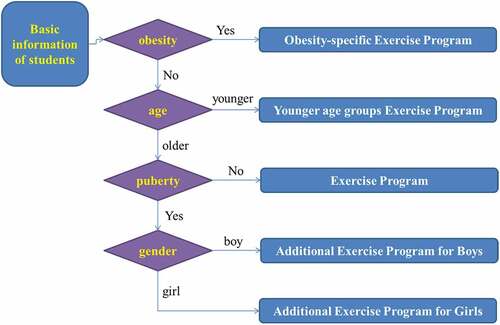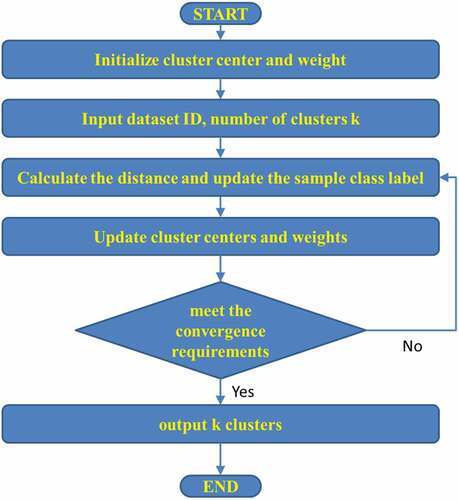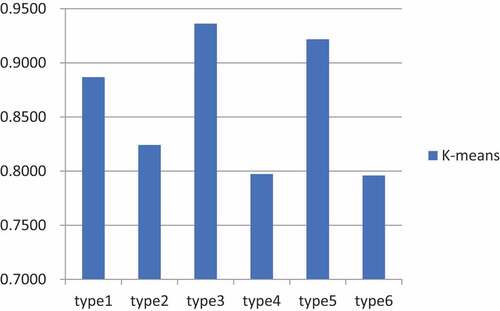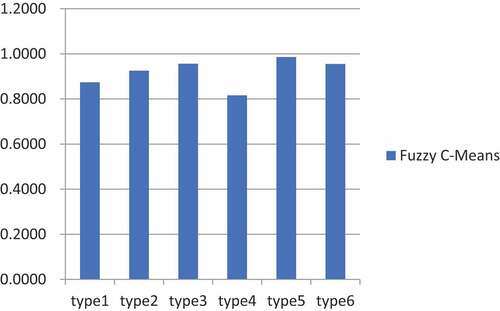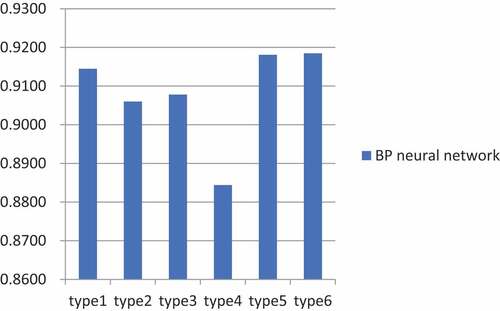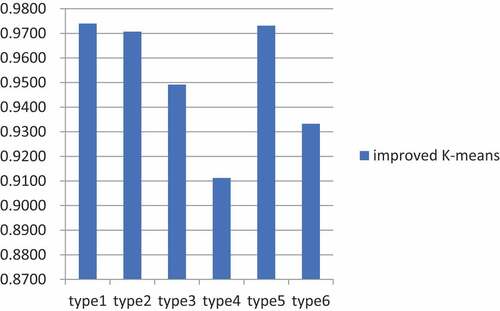 ?Mathematical formulae have been encoded as MathML and are displayed in this HTML version using MathJax in order to improve their display. Uncheck the box to turn MathJax off. This feature requires Javascript. Click on a formula to zoom.
?Mathematical formulae have been encoded as MathML and are displayed in this HTML version using MathJax in order to improve their display. Uncheck the box to turn MathJax off. This feature requires Javascript. Click on a formula to zoom.ABSTRACT
The development of society is greatly influenced by the physical strength of its individuals. As heirs of social construction, college students play a crucial role in national progress, and their physical health is an essential component of their well-being. However, the increasing competition for talent in today’s rapidly advancing world has led to significant pressure on college students in various aspects of their lives. Despite the importance of physical exercise, students often lack the time and knowledge to engage in appropriate exercise programs that suit their individual needs. To address this issue, this paper proposes an improved K-means algorithm for the classification of college students’ physical health data. The traditional K-means algorithm is known to be sensitive to noisy data, and thus, we introduce a variance-like weighting mechanism to improve its clustering accuracy. Our experimental results demonstrate that this algorithm can quickly and accurately cluster physical health data to provide a classification of each student’s physical fitness. By using the physical classification of each student, we can recommend more suitable exercise programs to prioritize physical health management. This study highlights the significance of physical health in college students and encourages education departments to improve the efficiency of physical health management.
1. Introduction
The physical and mental health of the human body are referred to as physical health. It is the basic condition and necessary guarantee for social individuals to carry out normal study, work and life (Happell et al. Citation2016; Park et al. Citation2020; Patel, Frederick, and Kidd Citation2018). There is a strong link between “physique” and “health.” One can only be healthy if they have a robust physique. If the physique of the country’s future successor is poor, it will be unable to support the mission of national construction. As civilization has advanced, people’s living conditions have substantially improved, and healthcare needs have become increasingly complex. College students should improve their physical fitness and make their bodies healthier to satisfy social growth demands. College students can be themselves and are no longer bound by the school or their parents. Many college students are likewise unaware of the importance of exercise. At universities, students have a lot of spare time. College students spend their after-school hours primarily in their dormitories. As a result, many college students are becoming obese. College students should acquire more and richer physical education content, as well as participate in extracurricular activities that interest them, in addition to obtaining information and skills. To fulfill the diverse sports interests of college students, college instructors should incorporate more enjoyment and interest into the physical education process. Adjust college students’ perceptions of physical health so that they are always aware of the importance of physical activity. Increase your physical fitness and enjoyment of exercise. Allow more college students to understand the concept of healthy sports. The government and universities have also devised a series of policies to boost the physical health of college students. Every year, the education department also invests major labor and material resources in college students’ physical fitness tests and the organization of sporting events. Yet, the effect is broad and does not address the underlying issue of college students’ physical health.
To fundamentally enhance college students’ physical health, it is vital to identify the primary factors influencing the healthy development of college students physical fitness. Once the reason has been recognized, the cure can be prescribed. A variety of factors influence college students’ physical health. The first is a person’s way of life. Physical health is built on regular life routines. College students’ erratic work and rest schedules are now a normal occurrence. For example, they stay up late, watch films, play games, and sleep during the day. Avoid breakfast in favor of unhealthy foods such as fast food, takeaway, etc. Some students even have smoking and drinking habits, which will jeopardize their health in the long run.
The second issue is a lack of appropriate exercise. College students lack exercise awareness and practice. Some college students assume that because they are young and in good health, they do not need to exercise. This is a common example of a lack of workout awareness. Most college students are invading the online world due to the ubiquity of mobile phones, tablets, and other gadgets and a broad choice of online entertainment applications. Besides attending classes, college students spend most of their time in dormitories. They rarely engage in various physical workouts and have no exercise habits. Many college students have not discovered an exercise regimen appropriate for their physical condition, and there have been incidents of random and blind exercise. On campus, there are frequently obese students. These students frequently hate or lack physical activity. The symptoms of body obesity can be improved when these people engage in physical exercise for some time. The entire individual appears to be more energetic. This is an example of the beneficial influence of physical activity on the human physique. Fourth, the education department and students focus on the performance of cultural courses rather than physical activity. This is because the main indicator of the education department’s assessment is often the student’s academic performance or admittance rate, and the student’s physical health-related assessment is given little weight. Students focusing solely on grades will prioritize academic excellence over physical fitness.
Physical health diagnosis is an important component of school physical education. For starters, scientific diagnosis can help teachers completely comprehend whether their teaching objectives are reasonable and their teaching methods are adequate. The second goal is to enable teachers to deliver hierarchical instruction in a targeted manner based on the outcomes of students’ physical fitness assessments, thereby improving students’ physical condition. Diagnosing students’ body shape, physiological condition, and physical quality is an important aspect of physical education teaching practice. Due to the long process of physical education and the complexity of the influencing elements of physical education teachers must regularly diagnose students’ physical fitness. And the instructional content is changed in real-time based on the results of the diagnosis. The education department is paying increasing attention to the physical health diagnosis of students. The research on students’ physical health diagnoses is still in its early stages.
Reference (Nualnetr and Thanawat Citation2013) evaluated the health-promoting effect of a physical therapy on students. The experiment analyzed the effect of physical therapy on physical health of students of different grades. Reference (Klainin-Yobas, He, and Lau Citation2015) conducts research on the physique of nursing students. The study found that students who exercised regularly had better physical and mental health. Reference (Johnston et al. Citation2022) conducts research on the physical health of the clergy. The conclusion of the study is that intervening in their physical health is helpful to their professional improvement. Reference (Beasley, Hoffman, and Andelin Citation2020) conducts research on the physical fitness of the student sports group, and the results show that a high level of health literacy can reduce the impact of negative factors on the physical health of this group. Reference (Masood Citation2021) explores the relationship between the various sports that college students participate in and their mental health. Most of the above methods use traditional questionnaires or scales to measure the relationship between the physical health of the subjects and other jobs. This method is subjective and the evaluation is time-consuming and labor-intensive. Therefore, this paper introduces the intelligent method (Gottlob Citation2008; Pierce et al. Citation2021; Radanliev and Rour Citation2021) and applies it to the physical health data analysis of college students. Since the traditional K-means algorithm (Capo, Perez, and Antonio Citation2022; Isa, Salamah, and Ngah Citation2009; Tulgar, Haydar, and Ersan Citation2017) is easily affected by noisy data and the clustering accuracy is not high, an improved K-means algorithm is proposed in this article. Since the variances of different K-means clusters are summed in the overall objective function, the variances of clusters with poor clustering quality will be averaged by the variances of other clusters. According to this situation, this paper proposes a cluster variance weighted objective function to improve the K-means algorithm. For the variance weights of different classes, this paper proposes two calculation methods to calculate the weights. The improved K-means is applied to the clustering processing of college students’ physical health data, and students are classified according to different physical health. According to different types of physique, suitable exercise programs are recommended to improve the physical health of college students.
The motivation behind this paper is to address the decline in physical health among college students, which has become a growing concern due to the increasing pressure on students in various aspects of their lives. The competition for talent in today’s rapidly advancing world has led to significant pressure on college students, leaving them with less time to engage in appropriate physical exercise programs that suit their individual needs. As a result, there is a need to prioritize physical health management among college students to ensure their well-being and promote national progress.
To address this issue, this paper proposes an improved K-means algorithm for the classification of college students’ physical health data. By using the physical classification of each student, the paper aims to recommend more suitable exercise programs to prioritize physical health management. The primary motivation behind this research is to encourage education departments and students to prioritize physical health management and improve the efficiency of college students’ physical health management. This study highlights the significance of physical health in college students and its impact on national progress.
2. Theories Related to Physical Health
2.1. Definition of Related Concepts
A person’s physical and mental health are referred to as their physical health, and is the basic condition and necessary guarantee for social individuals to carry out normal study, work and life. There is a close relationship between “physique” and “health.” Only with a strong physique can one be healthy (Abu-Omar and Rutten Citation2012; Happell, Platania-Phung, and Scott Citation2013). Health refers to a person’s physical and mental well-being. A useful and healthy constitution is the basic guarantee for people to engage in production and life. Judging a person’s health is multi-faceted, and can be judged by personal physique. If a person’s physique is good, then the person’s health is high. Physical fitness is an important feature of a person’s health, and the relationship between physical fitness and health is very close. The level of physical health can be measured by the comprehensive evaluation of three aspects: physical function, physical shape, and physical quality (Happell, Wilson, and Stanton Citation2017). The items that college students need to take the test include height, weight, lung capacity, 50-meter run, standing long jump, and sitting forward bend. The above items are tested for both male and female students. In addition, the 800-meter run and one-minute sit-ups are unique test items for girls, and the 1,000-meter run and pull-ups are unique test items for boys.
Physical health diagnosis, also known as physical health evaluation, refers to the scientific judgment of a person’s physical health status. Through physical health diagnosis, you can get a clear and accurate understanding of your physical health status, and lay a good foundation for targeted physical exercise and adjustment of eating habits in the future. The physical health diagnosis of middle school students in this paper refers to an in-depth analysis of the physical health test data of team students. Multi-dimensional evaluation and diagnosis of students’ physical health status are carried out based on the state’s physical health standards and the different needs of students and physical education teachers. On the one hand, it provides students with a scientific judgment on their own physical health. The diagnosis of students’ physical health is the key to testing the performance of physical education. The diagnosis results can help physical education teachers fully understand the rationality of their own teaching objectives and teaching methods. Then, according to the students’ physical health diagnosis results, targeted hierarchical or individualized and differentiated teaching will be carried out to gradually improve the students’ physical health status.
Intelligent recommendation of exercise program refers to a scientific method to guide people to carry out physical exercise in a purposeful and planned manner based on people’s physical health status and reality. The exercise program recommendation mentioned in this article refers to the exercise program formulated according to the age, gender and diagnosis of the students without other underlying diseases or movement disorders. Its structure includes exercise goals, exercise content, exercise time, exercise intensity, organization form, exercise frequency and precautions.
2.2. Construction of a Physical Health Diagnosis Model for College Students
The basis of the diagnostic model is to establish the relationship between the diagnostic indicators and the evaluation system, and then only the evaluation results can be used as the basis to obtain the diagnostic results through the analysis of the diagnostic model. Among the test indicators, the BMI index is a body shape test indicator. The evaluation results can be used to diagnose body type. The vital capacity is a physical function test index, and its evaluation results can be used to diagnose cardiopulmonary function. Several other indicators are physical fitness test indicators, which are used to diagnose students’ physical fitness from different levels and angles.
Establishing a corresponding relationship between the first-level indicators and the second-level indicators in the diagnostic indicators is the key to constructing a student’s physical health diagnosis. Relevant studies have shown that the commonly used method for the construction of the relationship between the indicators is to establish a one-to-one relationship between the main physical fitness and the diagnostic indicators. A test indicator corresponds to only one diagnostic indicator. The details are shown in .
Table 1. Physical health diagnostic indicators.
2.3. College students’ Physical Health Evaluation System
The physical health evaluation of students is the basis of this research. The classification results of physical health data are used as data support for exercise program design. This article uses the general test indicators for college students promulgated by the state to construct a student physical health evaluation system. The evaluation system of students is mainly constructed from two aspects: evaluation method and evaluation object. shows the student physical health evaluation system.
Table 2. Student physical health evaluation system.
Evaluation method refers to the standardized evaluation of students’ test index scores according to fixed standards. In this study, the evaluation methods are divided into two categories: graded evaluation and graded evaluation. The scoring evaluation is a quantitative evaluation of the performance of the test indicators, with a numerical score as the result. The rating evaluation is a secondary evaluation based on the scoring evaluation results. The result is a text-descriptive grade. For example, a student’s academic performance is scored on a scale of 90 to 100 as excellent, 80 to 90 as good, 70 to 80 as moderate, 60–70 as pass, and 0 to 60 as fail. The rating here is 5, which are Excellent, Good, Moderate, Pass, and Fail.
Evaluation object refers to the subject of evaluation. Individual evaluation and group evaluation are the two broad categories of evaluation objects. Individual evaluation is an assessment of individual students, and the results reflect the physical health level of individual students. Group evaluation refers to the evaluation conducted by the administrative class after grouping by gender, and the results reflect the overall physical health level of the class. This study focuses on the use of individual assessments.
3. Exercise Program Recommendation Method Based on Physical Health Data
3.1. Recommendations for Sports Intelligence
This paper proposes a sports intelligence recommendation system for college students. depicts the system’s architecture. The system mainly includes two modules, namely, the physical fitness classification module and the exercise program recommendation module. In the physique classification module, the physical measurement data of college students need to be collected first. BMI index, vital capacity, 50-meter running, sitting forward bend, standing long jump, pull-up, and 1000-meter/800-meter running are among the physical measurement data. Then, the collected data is preprocessed, including denoising and normalization. The processed data is divided into two categories: test data and training data. The physique classification model is trained using the training data. The improved K-means algorithm proposed in this paper is used in the physique classification model. The test sample obtains the classification result of physical health data through the trained model. The physique classification result is used as the input of the second module, and it is matched with the exercise scheme in the exercise scheme recommendation library, so as to recommend the exercise scheme suitable for the physical characteristics of each college student.
To sum up, there are two most important links in the exercise program recommendation based on physical health data. The first part is the classification of physical health data, and the second part is to match the appropriate exercise program according to the classification results. The improved K-means algorithm is used in this paper for classification. The classification process of students’ physical health based on the improved K-means algorithm is shown in :
The process of generating motion plan recommendation based on the classification result in the second step is shown in .
3.2. Improved K-Means Algorithm
When the clustering quality of some classes is not high, the variance of this class will be averaged by the classes with small variance. The clustering quality is not high, which means that the intra-class variance is large in mathematical theory. The result of this situation is that the optimal solution cannot be obtained as a whole. Aiming at this problem, this paper introduces a class variance weighting strategy (Moiseev et al. Citation2015). The core idea of this strategy is to improve the clustering quality of local classes by assigning different weights to each class. The objective function of the improved K-means algorithm is:
Where wk is the weight parameter of the class, is the influence factor for adjusting the weight parameter of the class, and the following conditions are required:
Computing the class weight parameter w is the key to the improved K-means algorithm proposed in this paper. This paper proposes two methods to calculate w. The specific calculation method is as follows. The first calculation method is as follows. A large penalty is imposed on classes with large mean variance, i.e., a higher weight parameter is assigned. The weight calculation formula of the jth class is as follows:
The second calculation method is as follows. A large penalty factor is assigned to the class with large variance, that is, a coefficient that makes J the maximum value is obtained. The above problem is transformed into the following optimization problem:
The Lagrange multiplier method is used to solve the weight, and the update formula of the weight is obtained as follows:
In order to make the convergence more stable, the weight update adopts the moving exponential weighted average method.
The following are the steps for implementing the improved K-means algorithm:
Step 1: Initialize the class center at random and set the initial weight of each class to wi = 1/K.
Step 2: Determine the distance between the sample data and the class center and update the sample’s class label L.
otherwise
Step 3: Update the class center ck:
Step 4: Update the class weights w using the calculation method of the first method.
Step 5: Repeat steps 2 to 5 until the change value of the class center is less than or equal to the iteration accuracy.
depicts the improved K-means algorithm flow:
4. Physical Fitness Monitoring Data Classification Experiment
The attributes of the physical fitness data dataset are the values of 7 individual measurement items, and the premise of intelligent recommendation of exercise programs is to obtain the classification results of physical fitness data. Only by obtaining accurate classification results as much as possible, can we design a sports program suitable for each college student. The improved k-means method is used in this paper to classify the physical fitness data of the student user group from freshman to senior year. First, the data needs to be collected, and then the collected data needs to be preprocessed. The preprocessed training data is then used for model training. Finally, the test data is input into the trained model for classification processing, and the classification result of the physical fitness data is obtained.
This article makes use of physical health data from university students. This data includes personal information of students as well as physical test data. Physical measurement items mainly include weight/height squared (BMI), vital capacity, sitting forward bend, standing long jump, 50-meter run, 1000-meter run (boys) or 800 meters (girls), pull-ups (boys) or sit-ups (girl). Due to the large amount of physical measurement data of college students, it may contain a lot of noise data. During the experiment, the data needs to be preprocessed first. For example, students who are missing some test attributes, such as sprinting, students whose lung capacity is 0, are removed. show some of the physical test data for boys and girls, respectively.
Table 3. Examples of physical health data for boys.
Table 4. Examples of physical health data for girls.
The physical health data of freshman to senior students were selected from the physical health database of colleges and universities. There are 4 grades, each grade draws 1000 sample data, including 500 boys and 500 girls. The dimension of each sample is 7. The network search method determines the optimal K value to be 6, dividing male and female students’ physical characteristics into six categories. The center point vectors corresponding to boys and girls are shown in .
Table 5. Center point vector of boys’ physical health data.
Table 6. Center point vector of girls’ physical health data.
show the cluster center vectors of male and female college students. Each sample data is aggregated into 6 categories according to the distance from the cluster center. According to the classification results of the obtained physique data, the appropriate exercise plan is recommended for each category of samples in combination with the exercise plan recommendation library. To validate the performance of the method proposed in this paper, the comparison algorithms introduced to classify physical health data include K-means (Klopotek Citation2020), fuzzy C-means clustering (Kanzawa and Miyamoto Citation2021), and BP neural network (Li Citation2019). Taking the data of boys as an example, the physical health categories of boys obtained by each algorithm are shown in :
The result graph demonstrates that in the classification results of physical fitness data obtained based on K-means, there are cases where multiple samples are wrongly classified into other categories. The classification results based on the FCM algorithm are better than those based on K-means. This is because the introduction of ambiguity factor reduces the influence of noisy data, thereby improving the classification accuracy. The results obtained based on the BP algorithm are similar to those obtained based on the FCM. The improved K-means algorithm clearly outperforms other algorithms in the classification of physical fitness data. As can be seen from the figure, there are very few misclassified samples, and the boundaries between categories are clear. This shows that the mechanism of adding weights to each class introduced in this paper is very effective, and finally can effectively improve the quality of local class clustering. After obtaining the classification result of physical health data based on the improved K-means proposed in this paper, the classification result is matched with the exercise plan in the exercise plan recommendation database. In the end, college students with different physiques can be recommended for their own exercise programs.
5. Conclusion
The impact of physical health on college students is very important. Without a good physique, one cannot effectively participate in the process of social development and construction. The physical health of college students is affected by internal and external factors. Internal factors refer to the congenital genetic conditions of college students’ bodies and the consciousness of sports. College students who lack the consciousness of sports are prone to problems such as irregular diet and indulging in online games. For the situation of such college students, if it is not improved for a long time, it is easy to cause serious physical health and psychological problems. External factors mainly originate from the mutual influence among school, society and family. Due to their different responsibilities and pressures, the three neglect the physical health of college students to varying degrees. Internal and external factors are not completely independent, and sometimes they can transform and promote each other. As a student work management department, it is critical to improve students’ physical health by performing corresponding physical exercise based on their physical characteristics. In order to address this issue, this paper proposes an improved K-means method for classifying physical health data from college students. A suitable exercise program is designed for each group based on the classification results. Experiments show that the improved K-means algorithm can produce accurate classification results. However, there is still room for further improvement in this study. For example, the number of categories can be dynamically adapted according to different objects. Therefore, a class-adaptive scheme can be introduced later. In addition, after recommending relevant sports programs, whether students are willing to implement them according to the corresponding programs is also an issue that needs attention. To improve students’ attention to physical exercise, the following measures need to be taken. First, attach importance to sports promotion. Use a new generation of multimedia technology to actively publicize and attract more college students to participate in physical activity. Allow students to enjoy sports and develop healthy habits. The second goal is to change college students’ bad habits. For example, colleges and universities can issue relevant policies to urge students to get up early to participate in physical exercise, and turn off the lights at night to enter a state of rest. The third is to increase investment in physical exercise equipment and venues. Only sufficient and abundant hardware facilities can ensure that students can carry out physical exercise smoothly. Fourth, regular sports activities. Colleges and universities can regularly hold relevant sports activities to attract more college students to participate in physical exercise.
In the case of this paper, the proposed algorithm may require additional resources such as computing power and time to process the physical health data of college students. However, it is worth noting that the benefits of prioritizing physical health management among college students may outweigh the costs in the long run.
Moreover, the proposed algorithm aims to improve the efficiency of college students’ physical health management by accurately classifying their physical health data and recommending suitable exercise programs. This can potentially save time and resources in the long run by reducing the need for trial and error in finding appropriate exercise programs for each student.
It is also worth noting that the proposed algorithm can be optimized to reduce the required resources by implementing parallel computing techniques or reducing the number of iterations needed for convergence. Future studies can further explore these possibilities to minimize the resource requirements of the proposed algorithm while maintaining its accuracy and effectiveness.
In addition, it is possible that there may be biases in the samples used in this study, either intentional or unintentional, which could potentially alter the findings. Biases can arise from various sources such as the selection of participants, the measurement tools used, or the data processing methods.
To mitigate the impact of biases, this study should have used a representative sample of college students, ensuring that participants are selected randomly and have diverse characteristics such as gender, age, and academic majors. Additionally, the measurement tools used to assess physical health should have been validated and standardized to minimize measurement biases. Furthermore, the data processing methods should have been transparent and objective to avoid any potential biases in data analysis.
Despite these measures, there may still be some biases that were not accounted for in this study, and this limitation should be acknowledged. Future studies can further investigate potential biases and evaluate their impact on the findings to ensure the validity and generalizability of the results.
Data availability
The labeled data set used to support the findings of this study is available from the corresponding author upon request.
Disclosure statement
No potential conflict of interest was reported by the authors.
Additional information
Funding
References
- Abu-Omar, K., and A. Rutten. 2012. Physical activity and public health. Germany: Bundesgesundheitsblatt-Gesundheitsforschung-Gesundheitsschutz.
- Beasley, L., S. Hoffman, and R. Andelin. 2020. Physical health literacy of student-athletes. Health & Social Care in the Community 29 (5).
- Capo, M., A. Perez, and J. A. Antonio. 2022. Core components of project-based intervention after acquired brain injury: Delivering meaningful groups online. International Journal of Language & Communication Disorders. doi:10.1111/1460-6984.12834.
- Gottlob, G. 2008. S., Fixed-parameter algorithms for artificial intelligence, constraint satisfaction and database problems. The Computer Journal 51 (3):303–1488.
- Happell, B., C. Platania-Phung, and D. Scott. 2013. Mental health nurse incentive program: Facilitating physical health care for people with mental illness? International Journal of Mental Health Nursing 22 (5):399–408. doi:10.1111/inm.12006.
- Happell, B., K. Wilson, C. Platania-Phung, and R. Stanton. 2016. Physical health nurse consultant role to improve physical health in mental health services: A carer’s perspective. International Journal of Mental Health Nursing 25 (3):243–50.
- Happell, B., K. Wilson, C. Platania-Phung, and R. Stanton. 2017. Physical health and mental illness: Listening to the voice of carers. Journal of Mental Health 26 (2):127–33.
- Isa, N. A. M., S. A. Salamah, and U. K. Ngah. 2009. Adaptive fuzzy moving K-Means clustering algorithm for image segmentation. IEEE Transactions on Consumer Electronics 55 (4):2145–53. doi:10.1109/TCE.2009.5373781.
- Johnston, E. F., D. E. Eagle, A. Corneli, B. Perry, and R. J. Proeschold-Bell. 2022. Rae Jean [1]seminary students and physical health: Beliefs, behaviors, and barriers. Journal of Religion & Health 61 (2):1207–25. doi:10.1007/s10943-021-01480-7.
- Kanzawa, Y., and S. Miyamoto. 2021. Generalized fuzzy C-means clustering and its property of fuzzy classification function. Journal of Advanced Computational Intelligence and Intelligent Informatics 25 (1):73–82.
- Klainin-Yobas, P., H. G. He, and Y. Lau, eds. 2015. Physical fitness, health behaviour and health among nursing students: A descriptive correlational study. Nurse Education Today 35 (12):1199–205.
- Klopotek, M. A. 2020. On the consistency of k-means plus plus algorithm. Poland: Fundamenta Informaticae.
- Li, X. 2019. Fault data detection of traffic detector based on wavelet packet in the residual subspace associated with PCA. Applied Sciences 9 (17):3491. doi:10.3390/app9173491.
- Masood, T. 2021. Association among determinants of physical activity and mental health in physiotherapy students,PAKISTAN. Journal of Medical & Health Sciences 14 (4):1287–90.
- Moiseev, A., S. M. Doesburg, R. E. Grunau, and U. Ribary. 2015. Minimum variance beamformer weights revisited. Neuroimage 120:201–13.
- Nualnetr, N., and T. Thanawat. 2013. Health-promoting behaviors of physical therapy students. Journal of Physical Therapy Science 21:269–276.
- Park, S. J., H. Jang, S. Park, and H. Behaviors. 2020. Physical health. And Health Care Utilization in Children with ADHD, Journal of Attention 24 (7): 1011–1019.
- Patel, P., T. Frederick, and S. A. Kidd. 2018. Physical health, community participation and schizophrenia. Journal of Health Psychology 23 (1):79–83.
- Pierce, J. D., B. Rosipko, L. Youngblood, R. C. Gilkeson, A. Gupta, and L. K. Bittencourt. 2021. Seamless integration of artificial intelligence into the clinical environment, our experience with a novel pneumothorax detection artificial intelligence algorithm. Journal of the American College of Radiology 18 (11):1497–505.
- Radanliev, P., and D. Rour. 2021. Review of algorithms for artificial intelligence on low memory devices. IEEE Access 9:109986–93.
- Tulgar, T., A. Haydar, and I. Ersan. 2017. Data distribution aware classification algorithm based on K-Means. International Journal of Advanced Computer Science and Applications 8 (9): 328–334.

